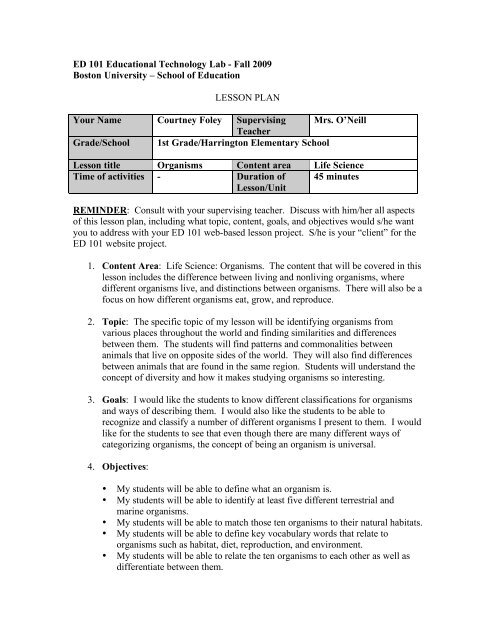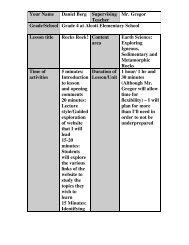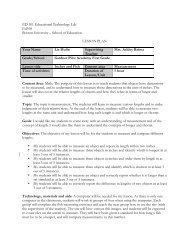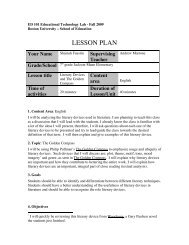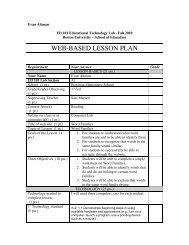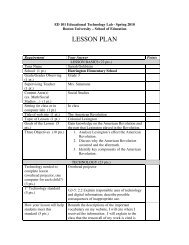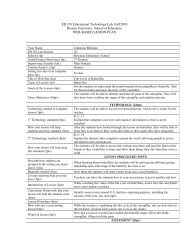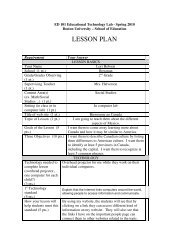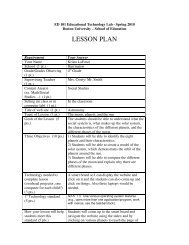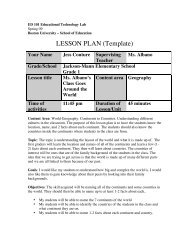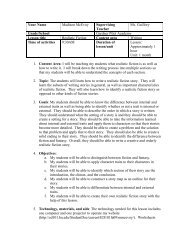Website Lesson Plan.pdf - ED101 - Boston University
Website Lesson Plan.pdf - ED101 - Boston University
Website Lesson Plan.pdf - ED101 - Boston University
Create successful ePaper yourself
Turn your PDF publications into a flip-book with our unique Google optimized e-Paper software.
ED 101 Educational Technology Lab - Fall 2009<br />
<strong>Boston</strong> <strong>University</strong> – School of Education<br />
LESSON PLAN<br />
Your Name Courtney Foley Supervising Mrs. O’Neill<br />
Teacher<br />
Grade/School 1st Grade/Harrington Elementary School<br />
<strong>Lesson</strong> title Organisms Content area Life Science<br />
Time of activities - Duration of 45 minutes<br />
<strong>Lesson</strong>/Unit<br />
REMINDER: Consult with your supervising teacher. Discuss with him/her all aspects<br />
of this lesson plan, including what topic, content, goals, and objectives would s/he want<br />
you to address with your ED 101 web-based lesson project. S/he is your “client” for the<br />
ED 101 website project.<br />
1. Content Area: Life Science: Organisms. The content that will be covered in this<br />
lesson includes the difference between living and nonliving organisms, where<br />
different organisms live, and distinctions between organisms. There will also be a<br />
focus on how different organisms eat, grow, and reproduce.<br />
2. Topic: The specific topic of my lesson will be identifying organisms from<br />
various places throughout the world and finding similarities and differences<br />
between them. The students will find patterns and commonalities between<br />
animals that live on opposite sides of the world. They will also find differences<br />
between animals that are found in the same region. Students will understand the<br />
concept of diversity and how it makes studying organisms so interesting.<br />
3. Goals: I would like the students to know different classifications for organisms<br />
and ways of describing them. I would also like the students to be able to<br />
recognize and classify a number of different organisms I present to them. I would<br />
like for the students to see that even though there are many different ways of<br />
categorizing organisms, the concept of being an organism is universal.<br />
4. Objectives:<br />
• My students will be able to define what an organism is.<br />
• My students will be able to identify at least five different terrestrial and<br />
marine organisms.<br />
• My students will be able to match those ten organisms to their natural habitats.<br />
• My students will be able to define key vocabulary words that relate to<br />
organisms such as habitat, diet, reproduction, and environment.<br />
• My students will be able to relate the ten organisms to each other as well as<br />
differentiate between them.
• My students will write and summarize about what they learned from the<br />
lesson and incorporate what they knew from outside of the classroom.<br />
• My students will point out what they do not understand and enquire about it.<br />
5. Technology, materials and aids: In my lesson, I will use my Mac laptop, the<br />
Internet, worksheets, and a picture book. I will have one picture book, one<br />
computer, and one worksheet for each student (approximately twenty<br />
worksheets).<br />
6. Procedures/methods:<br />
a. Overview: I will commence by reading the picture book, which will pertain<br />
to organisms. I have not yet chosen the picture book. After that we will have<br />
a discussion about the book before looking at the website. The website will<br />
have factual information about organisms as well as activities to do together<br />
as a class. After, I will hand out a worksheet that summarizes the lesson.<br />
Once the students finish the worksheet, they will write a small story about an<br />
encounter they once had with an organism.<br />
b. Introduction: The lesson will begin by introducing a picture book that has to<br />
do with organisms. We will read it together and then discuss it.<br />
c. Activities: After reading the picture book to the students, we will have a<br />
discussion on what everyone already knows about organisms. We will make a<br />
list of what they know and what they would like to find out. From there, we<br />
will look at the website I created on the projector. We will read the facts on<br />
the website out loud. Students will have opportunities throughout the lesson<br />
to ask questions if they do not understand something. Once we finish the<br />
activities on the website, the students will finish a worksheet that asks<br />
questions and summarizes what we went over on the website and in the<br />
picture book. We will look at the list to see if the students had learned what<br />
they had been questioning before the website. Finally, the students will write<br />
a story, as they do during Writer’s Workshop, about an encounter they once<br />
had with an organism.<br />
d. Follow-up: After the lesson, the students will have a small assignment to go<br />
home and find out information about their favorite organisms to share with the<br />
class.<br />
7. Curriculum Frameworks: (Optional)*<br />
Standard #8<br />
• Observe and discuss animals in their natural habitats.<br />
• Observe and record the names of plants and animals in your neighborhood or on a<br />
field trip, then prepare a field guide that describes these animals.<br />
• Choose an animal and provide students with a list of its habitat needs. Allow the<br />
students to imagine that they are that animal. Can they find what they need to<br />
survive (i.e., food, water, shelter/space)?
8. Technology Frameworks: (Required)<br />
K-2: 1.2 Explain that icons (e.g., recycle bin/trash, folder) are symbols used to<br />
signify a command, file, or application.<br />
K-2: 1.3 Identify, locate, and use letters, numbers, and special keys (e.g., space<br />
bar, Shift, Delete) on the keyboard.<br />
K-2: 1.9 Explain that the Internet links computers around the world, allowing<br />
people to access information and communicate.<br />
K-2: 2.1 Follow classroom rules for the responsible use of computers, peripheral<br />
devices, and resources.<br />
K-2: 2.6 Follow the school rules for safe and ethical Internet use. (Use of Internet<br />
in this grade span is determined by district policy.)


